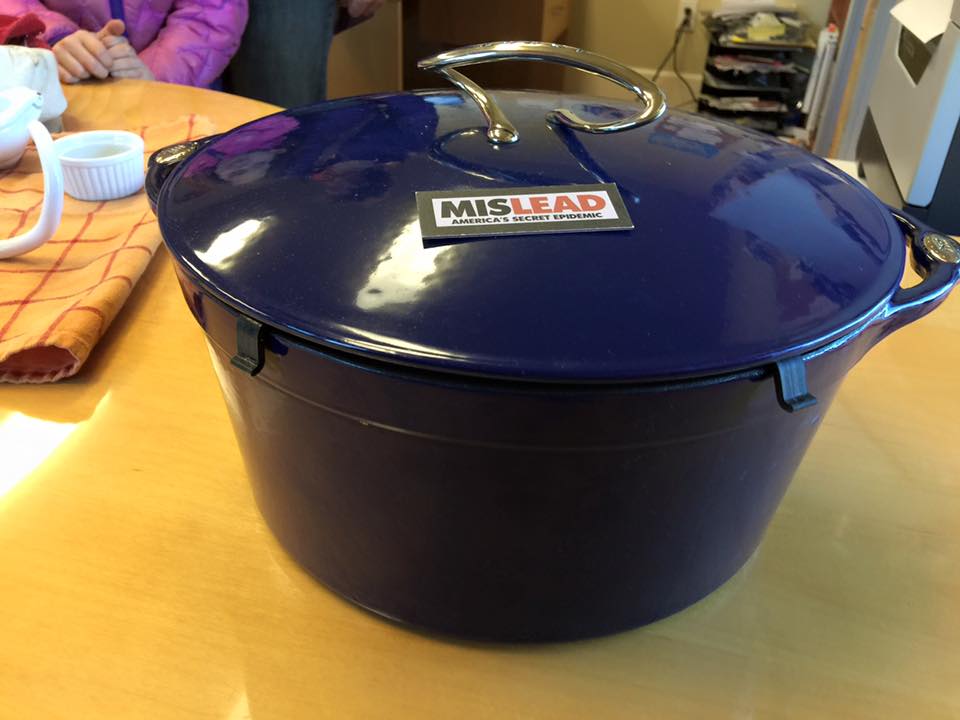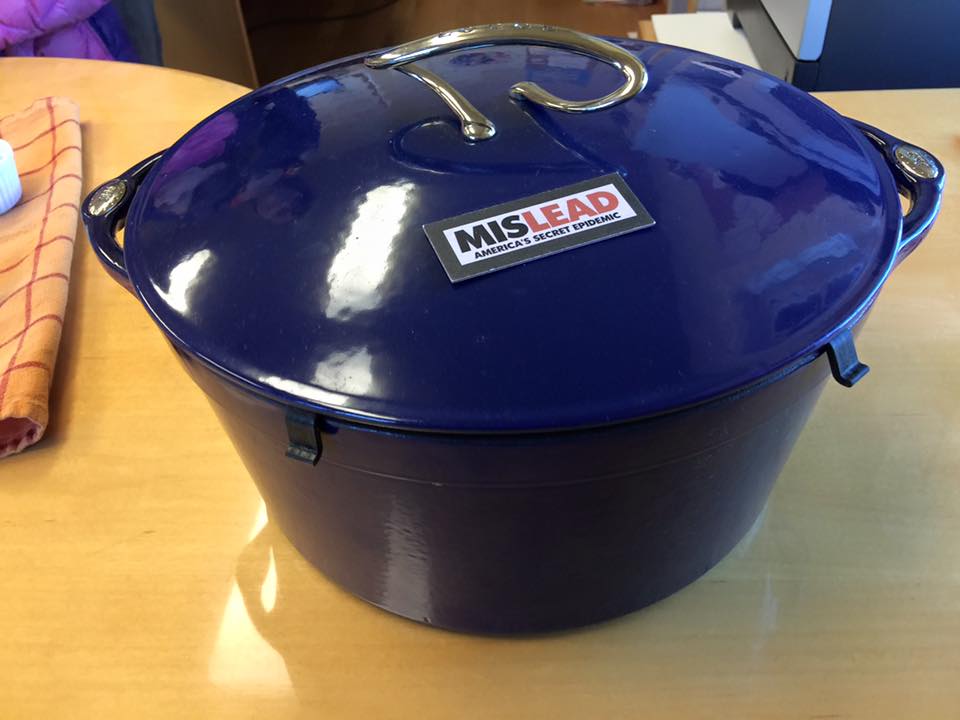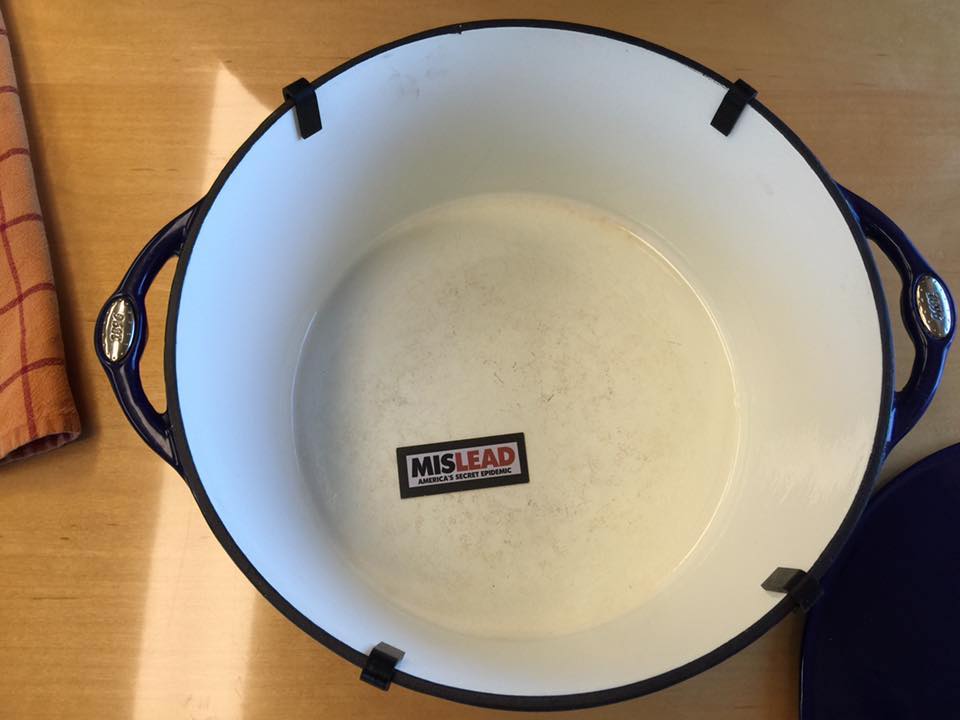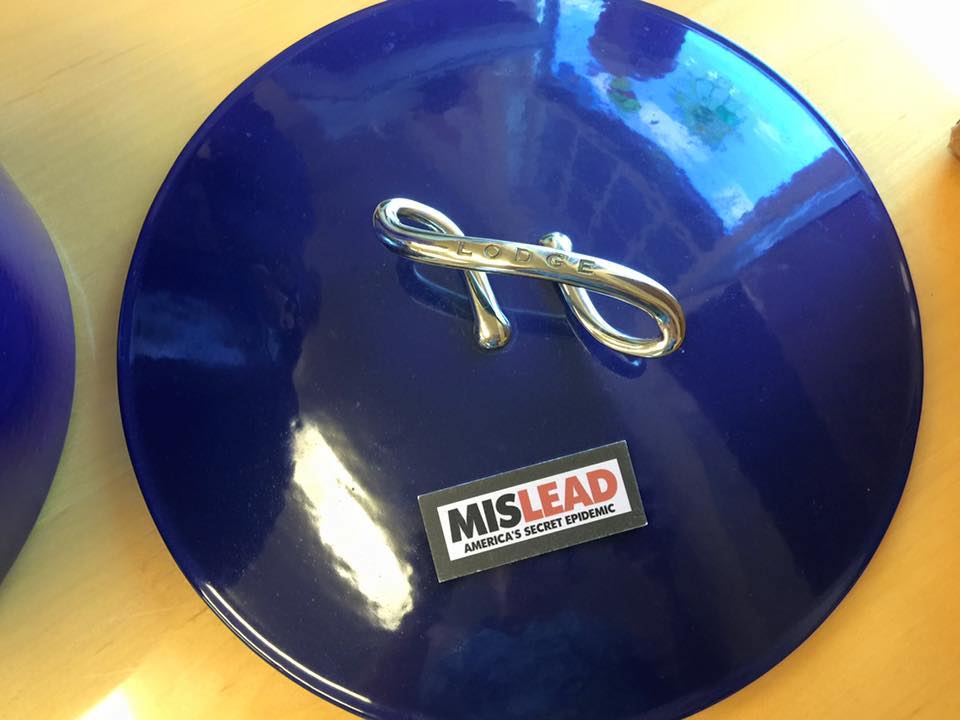Dark Blue & White Lodge Cast Iron Enameled Dutch Oven (c. 2006): 1,693 ppm Lead + 555 ppm Arsenic
I tested this Lodge enameled cast iron dutch oven back in 2016. With more recently tested items I capture a much more comprehensive panel of test results, however with this one I just captured the following two sets of readings (which are enough to support my opinion that enameled cast iron should always be avoided because there is all-too-often a possibility that it is positive for one or more toxicants!) The owner of this piece told me they had purchased it around 2006.
When tested with an XRF instrument this piece had the following readings…
Blue Enamel (outside):
- Lead (Pb): Non-Detect
- Arsenic (As): 555 ppm
White Enamel (inside food surface):
- Lead (Pb): 1,693 ppm
- Arsenic (As): 508 ppm
Regardless of whether or not this type of item is leach tested at the time of manufacture (and determined by current standards to be safe because it is not leaching at that time) I personally do not believe that there is any defensible reason to have Lead and ARSENIC in our cookware.
Click here to see more cast iron pieces I have tested.
Click here to see more Lodge brand pieces I have tested.
Click here to see more enamelware pieces I have tested.
Safer choices for cookware include plain (undecorated) stainless steel, plain undecorated cast iron and plain undecorated clear glass. These are the types of things I use in my home. They also tend to be inexpensive (as well as free of toxicants!)
I don’t currently have a dutch oven brand that I recommend or would use in my home (and I have never cooked in one of these in my 49 years on the planet – so am also not sure what I might use one for if I had one!)
Lodge is otherwise a good brand and their plain (unadorned, without enamel coatings) cast iron pieces are generally a good safer choice (from a toxicant perspective). Here’s a link to a good example of a safer Lodge cast iron piece (that is likely to be free of toxicants like Lead, Cadmium, Arsenic and Mercury!): https://amzn.to/2VT2GBz*
Please note, I have heard that Lodge pieces sometimes arrive broken in shipping – a fact which might indicate they are weaker cast iron than some of the more expensive brands (or than the vintage cast iron of our parents and grandparents) … however the price point for Lodge pieces seems to make that a reasonable risk. If you can get ahold of your grandmother’s vintage or antique cast iron (when she is ready to pass it on) that’s always the best choice! I have my great grandmother’s pans that I use (and I believe, based on family lore, that some of these are from the late 1800s!)
Thank you for reading and for sharing my posts.
Please let me know if you have any questions.
Tamara Rubin
#LeadSafeMama
*Amazon links are affiliate links. If you purchase something after clicking on one of my affiliate links I may receive a small percentage of what you spend at no extra cost to you. Thank you for supporting my advocacy work in this way!
Never Miss an Important Article Again!
Join our Email List







I have a Wolfgang Puck dutch oven that looks similar to this one. It has blue on the outside and the inside is white. I assume it is enamel covered cast iron. Do you have any information on this? I bought this at Homegoods. If I called the company, what would I ask to determine its safety?
Hi Anita, I don’t recall testing anything from his brand. I thing test results would likely be similar (depending on the age) and I generally recommend avoiding all enameled cast iron as a result of the consistency of my findings (across brands and across varying years of manufacture.) You could ask the company if there is Lead in their enamel, but most companies will not know the answer. Most companies will answer “we have always complied with all regulatory standards” – which is side stepping the question entirely, since there is not a regulatory standard limiting the total XRF detectable Lead in cookware. Here’s a link about participating in the testing I do: https://tamararubin.com/2017/07/subscribe-in-support-of-my-advocacy-work-you-can-become-eligible-to-send-in-a-box-of-your-things-for-testing/
Thanks for commenting!
Tamara
Does your equipment detect barium? I have one of these and I’m no longer using it because the enamel started to lift and flake off, but both my son and I have barium showing in our hair test and I’m not sure of the source but suspect the lodge cookware.
Hi Chris,
Yes it does detect Barium. With the older testing I have done I did not report Barium levels, however I have started to do that (reporting all metals detected). You can look at some of the other enameled pieces I have tested more recently to see if any of them list Barium as a detected element. I am not sure off the top of my head if that is the case. It is often found in glassware, especially blown glass pieces. I also find Antimony in a lot of the enameled pieces.
Tamara
Chris – here’s all the posts on the site that reference Barium: https://tamararubin.com/?s=barium
Tamara
Thank you for sharing all of your test results. They are both informative and eye-opening. I am curious if you have ever tested Le Creuset products made in France? Most of their cookware is enamel coating, however I am unclear if manufacturing differs significantly from the USA with the type of material they use in their products.
Here you go Heather: https://tamararubin.com/2022/04/le-creuset-overview/
Found used lodge Dutch of exactly the same as you have pictured. I now wish I didn’t buy it. I haven’t used it yet.
What is the safe level of lead in ppm …this has 1693ppm.
Thank you
Under 90 ppm is considered safe.
t